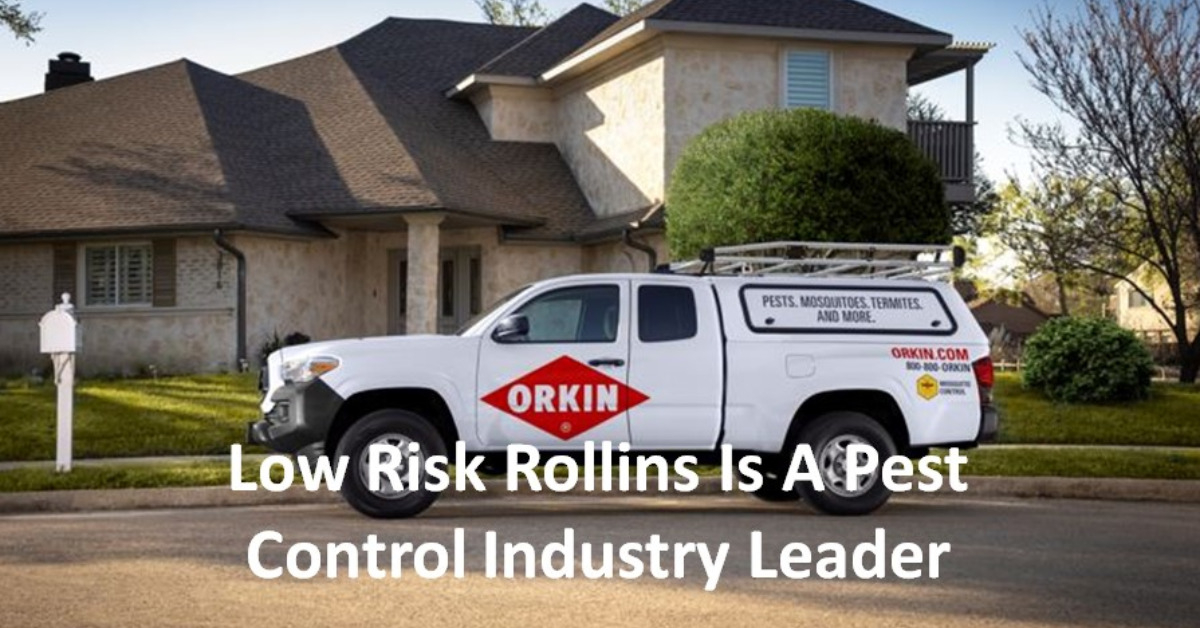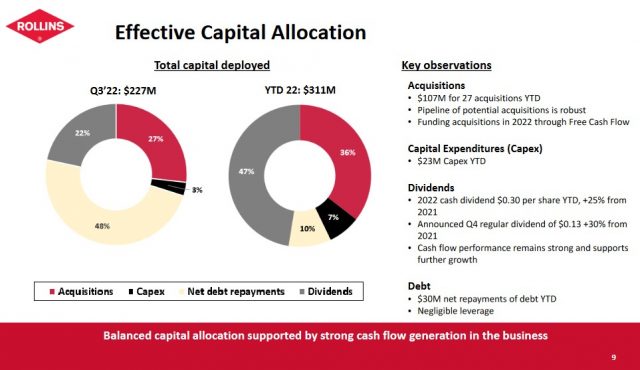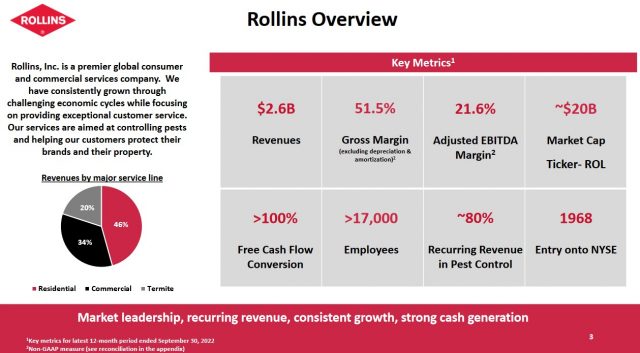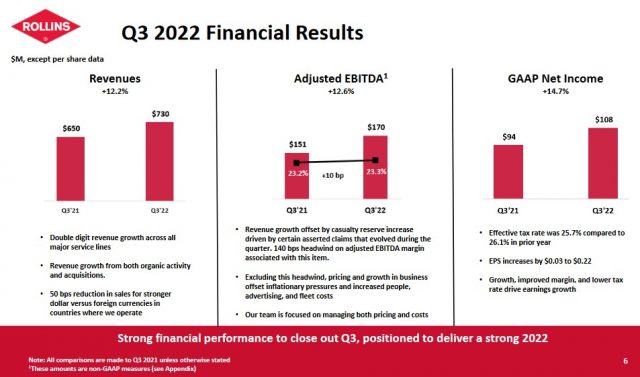Contents

Low-risk Rollins (ROL) is a pest control industry leader with ~80% recurring revenue and 20+ years of growth regardless of the economic cycle.
I last reviewed the company in this July 29 post at which time it had just reported Q2 and YTD2022 results.
While ROL released Q3 and YTD2022 results on October 26, our recent purchase of a second home and relocation has resulted in this post being delayed.
Business Overview
ROL provides essential pest and wildlife control services and protection against termite damage, rodents and insects to more than 2 million residential and commercial customers from more than 800 Company-owned and franchised locations in over 70 countries.
This highly fragmented industry (there are more than 20,000 competitors in the US alone) is experiencing high growth. ROL, being one of the largest industry participants, is well-positioned to grow organically and acquire many smaller industry participants.
A good overview of the industry and its long-term growth prospects is accessible here. In addition, you may wish to refer to ROL's website and FY2021 Form 10-K to gain a good understanding of the company.
The November 9, 2022 Baird 2022 Global Industrial Conference presentation also provides a good overview of ROL's strong business model. ROL consistently generates strong Free Cash Flow (FCF) which enables it to effectively grow organically and through multiple acquisitions.
In Q3, ROL made 5 acquisitions totalling ~$60 million. They were made in Canada, Australia and the U.S.
In August, ROL acquired Bug House Pest Control, serving residential and commercial customers throughout Central and South Georgia. Bug House Pest Control was founded in 1993 and has grown to be one of the largest pest control companies in Georgia.
YTD, ROL has made 27 acquisitions totalling just over $110 million. It also has a strong pipeline of potential acquisition opportunities.
Financials
Q3 and YTD2022 Results
Please refer to ROL's Form 10-Q, Form 8-K, and Earnings Presentation.
The following images extracted from ROL's Q3 2022 earnings presentation provide a very high-level overview.

Source: ROL Q3 2022 Earnings Presentation - October 26, 2022

Source: ROL Q3 2022 Earnings Presentation - October 26, 2022
ROL continues to experience various inflationary pressures with fleet-related costs, specifically fuel and vehicle repairs and materials and supplies, being the primary areas impacting the company. It is, however, taking proactive actions to mitigate these pressures.
In Q3, management witnessed the beginning of a gradual improvement in fuel prices. ROL has also reduced its overall mileage per service visit through routing and scheduling initiatives.
On the fleet side, ROL is keeping its trucks longer thereby leading to higher than normal costs for items such as basic maintenance and tires as well as some repairs outside of the norm.
Recently, a small number of new fleet vehicles are arriving from ROL's primary manufacturers. While this will help reduce vehicle repair costs, the quantities are less than what ROL typically receives by this point of the year. ROL's manufacturers, however, indicate that the supply environment is improving and that ROL can potentially expect an uptick in inflow levels for new vehicles in the coming quarters. Similar assurances made last year failed to materialize so ROL is closely monitoring the situation.
On the labour front, ROL successfully integrated a recruiting software platform to allow its hiring managers to more efficiently recruit and engage with potential new candidates. This talent recruitment platform makes it easier for prospective team members to explore open positions on ROL's career portals; applicants can now apply for open positions in just a few minutes and can easily do so from a mobile device. In addition, ROL's hiring managers can more easily pre-screen candidates, communicate with them and schedule interviews in a more streamlined way.
As a result of this improved process, ROL averaged 35,000 job applicant submittals per month in Q3. Over the last five months, ROL almost matched the total FY2021 employment application submittals.
Unearned Revenue
The current portion of unearned revenue at FYE2021, Q1 - Q3 2022 was ~$0.145B, ~$0.156B, ~$0.165B and ~$0.167B. This unearned revenue represents the receipt of customer funds before the rendering of services. This is a current liability because ROL will provide services within the coming 12 months. Once the services are provided, the liability is reduced and ROL reports the appropriate revenue and related expenses on its Income Statement.
A much smaller amount ($29.5 million and $18.4 million as of September 30, 2022, and December 31, 2021) is included in 'Other long-term accrued liabilities'. The majority of this is recognized over 5 years or less with immaterial amounts recognized through 2032.
As noted in prior ROL posts, investors need to account for this when looking at ROL's current ratio (current assets/current liabilities) and quick ratio (current assets minus materials and supplies/current liabilities). If we deduct, ~$167 million of the current portion of unearned revenue from ~$510 million of total current liabilities on September 30, ROL has ~$343 million of current liabilities. Its current assets, however, amount to ~$400 million of which ~$324 million is cash and cash equivalents and trade and finance receivables.
Adjusted EBITDA
The Q3 2022 Form 8-K includes adjusted EBITDA on page 9 of 11.
Free Cash Flow (FCF)
In FY2011 - FY2021, ROL generated FCF of (in millions of $): 136, 123, 144, 165, 157, 193, 211, 272, 292, 413, and 375. In the first 3 quarters of FY2022, ROL has generated ~$320 of FCF, a ~14.6% increase relative to 2021 (refer to page 9 of 11 in the Q3 Form 8-K). It generated just over $120 million of FCF in Q3 2022 and increased FCF by ~65% relative to Q3 2021 results.
ROL's FY2017 - YTD2022 FCF conversion rate is 118%, 112%, 114%, 158%, 107% and 114%.
FY2022 Guidance
Management does not provide guidance. Furthermore, only 6 brokers provide FY2022 and FY2023 EPS estimates and only 4 provide FY2024 estimates. EPS estimates, as explained at the beginning of the Valuation section of this post (see below), are not a good metric to gauge ROL's performance.
Credit Ratings
No rating agency rates ROL's debt.
Details of ROL's lease commitments and debt facilities are found in Notes 7 and 9 in the Q3 Form 10-Q.
ROL's current portion of LT Debt and LT Debt (~$125 million) is $30 million less than FYE2021. Its cash position is also $16 million higher than FYE2021.
Debt remains negligible and debt-to-EBITDA is well below 1 times on a gross level. In addition, cash balances at the end of Q3 approximated LT Debt and LT Debt balances.
To comply with applicable debt covenants, ROL must maintain a leverage ratio of not greater than 3:1. The Leverage Ratio is calculated as of the last day of the most recent fiscal quarter-end. ROL complies with this covenant at the end of Q3 2022 and expects to maintain compliance throughout FY2022.
Dividend and Dividend Yield
In Q3, ROL distributed ~$50 million of dividends and YTD has distributed ~$147.6 million.
ROL's dividend history reflects the declaration of a 'special variable dividend' in November with distribution in early December. At the time of my July review, I envisioned $0.40 in regular dividends in 2022 and potentially a $0.09 'special variable dividend'.
No 'special variable dividend' has been declared in FY2022 and it appears this may have been eliminated. Instead, ROL has announced a 30% increase in its quarterly dividend ($0.10 increased to $0.13).
With shares currently trading at $42.46, the forward dividend yield is ~1.22%.
This low dividend yield is likely to dissuade some investors from investing in ROL. Investors, however, should focus on an investment's total potential long-term investment return. The bulk of ROL's future total investment return is likely to continue to be predominantly in the form of capital appreciation.
In 2012, ROL's Board authorized the purchase of up to 5 million shares of the company’s common stock. After adjustments for stock splits, the total authorized shares under the share repurchase plan are 16.9 million shares. It did not repurchase shares on the open market during the first 9 months of 2022 nor the same period in 2021. In total, 11.4 million additional shares may be purchased under the share repurchase program.
ROL did, however, repurchase $7.0 million and $10.6 million for the 9 months ending September 30, 2022 and 2021, respectively, from employees for the payment of taxes on vesting restricted shares. Furthermore, it did repurchase $10.7 million, $8.3 million, and $10.0 million of common stock in FY2021, FY2020, and FY2019, respectively, from employees for the payment of taxes on vesting restricted shares.
The number of shares outstanding for the past ~8 years has been relatively stagnant at ~491 - ~492 million shares.
Stock Splits
ROL has had stock splits over the years with the most recent being a 3-for-2 stock split that was announced on October 27, 2020.
Valuation
The high amortization expense related to multiple acquisitions makes it impractical to value ROL using Earnings per Share (EPS). This is because Depreciation and Amortization are significant components of the 'Adjustments to reconcile net income to net cash provided by operating activities' in the Condensed Consolidated Statement of Cash Flows.
Management agrees and in 2021 it started to present the following metrics:
- Earnings before interest, taxes, depreciation and amortization (EBITDA)
- Free Cash Flow
The rationale for presenting these additional metrics is to more properly illustrate ROL's strong ability to generate cash.
ROL uses the simple approach to define free cash flow, which is net cash provided by operating activities less the purchase of equipment and property.
ROL's historical Net Cash Provided by Operating Activities (OCF) and FCF are:
- FY2018 - ROL generated ~$299 million and ~$272 million in OCF and FCF.
- FY2019 - ROL generated ~$320 million and ~$292 million in OCF and FCF.
- FY2020 - ROL generated ~$436 million and ~$413 million in OCF and FCF.
- FY2021 - ROL generated ~$402 million and ~$375 million in OCF and FCF.
When I wrote my April 30, 2022 post, ROL had reported ~$87.5 million and ~$79.5 million in Q1 OCF and FCF. I estimated ROL would generate ~$360 million and ~$320 million in OCF and FCF in FY2022. Using these projections, I arrived at:
- OCF/share of ~$0.73 ($0.36B/492.3 million shares). Using the current ~$33.50 share price, the valuation based on OCF is ~46.
- FCF/share of ~$0.65 ($0.32B/492.3 million shares). Using the current ~$33.50 share price, the valuation based on FCF is ~52.
At the time of my July post, ROL had reported ~$127.3 million and ~$119.4 million in Q2 OCF and FCF and ~$214.8 million and ~$199 million in YTD OCF and FCF. Given ROL's YTD results, I revised my FY2022 OCF and FCF projections to $420 million and $400 million. Using these projections, I arrived at:
- OCF/share of ~$0.85 ($0.42B/492.5 million shares). Using the current ~$38 share price, the valuation based on OCF is ~44.7.
- FCF/share of ~$0.81 ($0.4B/492.5 million shares). Using the current ~$38 share price, the valuation based on FCF is ~47.
After the first 9 months of operation, ROL has generated OCF and FCF of ~$342.5 million and ~$320 million. I now expect ROL's FY2022 OCF and FCF to be ~$450 million and ~$420 million.
The following is a rough approximation of ROL's valuation based on OCF and FCF:
- OCF/share of ~$0.91 ($0.45B/492.4 million shares). Using a $42.46 share price, the valuation based on OCF would be ~46.7.
- FCF/share of ~$0.85 ($0.42B/492.4 million shares). Using a $42.46 share price, the valuation based on FCF is ~50.
The vast majority of ROL's historical total return has come from capital appreciation and I expect the same going forward. This makes it exceedingly important to acquire shares when they are reasonably valued.
If ROL's share price were to retrace to the low - mid $30s we witnessed in August - October, ROL's valuation based on OCF and FCF would be:
- OCF/share of ~$0.91 ($0.45B/492.4 million shares). Using a $33 share price, the valuation based on OCF would be ~36.
- FCF/share of ~$0.85 ($0.42B/492.4 million shares). Using a $33 share price, the valuation based on FCF is ~39.
Even at $33/share, ROL's valuation raises eyebrows. This is, however, an industry leader. Management projects ROL can once again double in size over the coming decade. I think this is very possible, and therefore, paying up to acquire shares is reasonable. Acquiring shares at the current ~$42.46, however, does not seem prudent.
Final Thoughts
My objective is to generate double-digit long-term investment returns without taking on unnecessary risks. I, therefore, pay particularly close attention to a company's debt levels, profitability, free cash flow, and capital allocation.
While the pest control industry is not 'sexy', it is relatively resistant to economic cyclicality. The industry, however, is highly fragmented so I want to invest in an industry leader. Low-risk Rollins is a pest control industry leader with ~80% recurring revenue and 20+ years of growth regardless of the economic cycle. These strengths drew my attention to the company when I initiated a 500-share position at ~$33.14/share on June 10, 2021 in one of the 'Core' accounts within the FFJ Portfolio.
There is currently some concern about the state of the consumer. ROL's residential business experienced some drag at the end of Q3. Management indicates Hurricane Ian, which hit at the end of Q3, definitely resulted in a revenue drag in parts of Florida and South Carolina where ROL's business is very heavily weighted on the residential side. Although residential leads have been down for some time, ROL is noticing that the lead quality and lead closure rates are improving which leads to increased sales.
A common theme in all the earnings call transcripts I read is the expression of concern by senior executives about a challenging economic environment and a potentially difficult 2023. I envision a nice broad market pullback in 2023 and ROL's share price could be caught in any downdraft. It might, therefore, be wise to exercise patience and hold off on acquiring ROL shares; there is typically a wide variance between ROL's 52-week low/high share price and the share price is near the 52-week high following a recent run-up.
I wish you much success on your journey to financial freedom!
Note: Please send any feedback, corrections, or questions to [email protected].
Disclosure: I am long ROL.
Disclaimer: I do not know your circumstances and do not provide individualized advice or recommendations. I encourage you to make investment decisions by conducting your research and due diligence. Consult your financial advisor about your specific situation.
I wrote this article myself and it expresses my own opinions. I do not receive compensation for it and have no business relationship with any company mentioned in this article.



